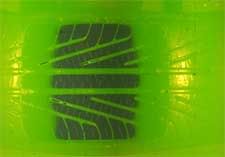Air Pressure vs. Wet Performance
Most drivers realize that tire load capacity is determined by tire size and inflation pressure. Larger tires and higher inflation pressures provide more load capacity, while smaller tires and lower tire pressures provide less.
An underinflated tire will tend to wear the shoulder areas of the tread faster than the center. This is because there is insufficient air pressure to allow the center of the tread to carry its fair share of the weight. A correctly inflated tire receives appropriate support from the contained air pressure to provide an even distribution of load across the footprint. And while most drivers recognize that this has a significant impact on tire wear, rolling resistance and durability, only a few realize it also has a noticeable influence on how effectively the tires can resist hydroplaning to maintain wet traction.
As they taught us in physics class, you can compress and move a gas quite easily, but you cannot compress liquids and it requires significant energy to move them. Our tires easily push air around and through their tread designs as they roll. However, when water pools in highway ruts and builds up on the road surface during rainstorms, the vehicle's speed and weight, as well as the tires' tread designs, tread depths and evenness of their footprint pressures determines if and when the tires will be forced to hydroplane.
One of the ways tire manufacturers evaluate their products' hydroplaning and wet traction effectiveness is by driving them over a glass plate covered with a specific depth of water. The water is dyed for better visibility and to allow high-speed cameras in underground rooms to photograph the tires from below. Michelin has provided several photographs of its HydroEdge premium All-Season tire to help illustrate this tech feature.

The first photograph shows a tire properly inflated to 35 psi sitting still in the water on the glass plate. This provides an accurate idea of the tire's footprint size and shape. The black area is where the tire's rubber compound is pressed on the glass, and the green areas identify water in the tire's circumferential and high-angle lateral grooves, and on the remainder of the glass plate. A properly inflated tire will have enough pressure in the center of its tread to resist collapsing.

The next picture is of a tire properly inflated to 35 psi, driving across the glass at 60 miles per hour. If the glass plate were dry, the footprint size would be virtually identical to the first picture because air does not prevent the tread from contacting the plate. However with standing water on the plate, the tire's tread depth and tread design must evacuate the water as the tire rolls across the plate at 88 feet per second. You will notice that the footprint still shows good contact with the plate, but is slightly smaller than the static tire's footprint.
A tire that is slightly underinflated will apply less pressure to the center of the tread and it will become slightly concave.

The next picture is of a tire inflated to only 30 psi, again driving across the glass at 60 miles per hour. With the same amount of standing water on the plate, the center of the tire's tread is lifted as the tread design unsuccessfully attempts to evacuate water as the tire rolls across the plate. You will notice that the actual footprint shows poor contact with the plate and is significantly smaller than the footprint in the photograph of the properly inflated tire.
A tire that is significantly underinflated will allow the center of the tread to collapse and become very concave, trapping water rather than flowing it through the tread design.

The final picture is of a tire inflated to only 25 psi, driving across the glass plate at 60 miles per hour. With the same amount of standing water, the water lifts the center of the tire's tread as its footprint rolls across the plate. You will notice that the actual footprint shows little contact with the plate and has been virtually reduced to the shoulder areas.
Members of The Tire Rack team had the chance to experience the affects of air pressure on wet performance at Michelin's Laurens Proving Grounds. Drivers were given the opportunity to compare identical cars on a wet-handling course with the exception of one car having four properly inflated tires (35 psi) and the other car having significantly underinflated tires on the rear axle (25 psi).
While driving at the edge of a tire's ability in wet conditions is challenging, the car with the properly inflated tires provide handling that was predictable. Driving the car with the underinflated rear tires proved to be much more difficult to drive and forced the driver to slow down to retain control, producing lap times that were several seconds slower than the properly inflated car.
While tire manufacturers can develop tires with great hydroplaning resistance and wet traction, poor maintenance of tire inflation pressures can make a great tire awful.
Adjust your tire pressures as indicated on the vehicle tire placard or in the owner's manual. Check you inflation pressures at least once a month and before highway trips.
All content belongs to © 2006, www.tirerack.com
Most drivers realize that tire load capacity is determined by tire size and inflation pressure. Larger tires and higher inflation pressures provide more load capacity, while smaller tires and lower tire pressures provide less.
An underinflated tire will tend to wear the shoulder areas of the tread faster than the center. This is because there is insufficient air pressure to allow the center of the tread to carry its fair share of the weight. A correctly inflated tire receives appropriate support from the contained air pressure to provide an even distribution of load across the footprint. And while most drivers recognize that this has a significant impact on tire wear, rolling resistance and durability, only a few realize it also has a noticeable influence on how effectively the tires can resist hydroplaning to maintain wet traction.
As they taught us in physics class, you can compress and move a gas quite easily, but you cannot compress liquids and it requires significant energy to move them. Our tires easily push air around and through their tread designs as they roll. However, when water pools in highway ruts and builds up on the road surface during rainstorms, the vehicle's speed and weight, as well as the tires' tread designs, tread depths and evenness of their footprint pressures determines if and when the tires will be forced to hydroplane.
One of the ways tire manufacturers evaluate their products' hydroplaning and wet traction effectiveness is by driving them over a glass plate covered with a specific depth of water. The water is dyed for better visibility and to allow high-speed cameras in underground rooms to photograph the tires from below. Michelin has provided several photographs of its HydroEdge premium All-Season tire to help illustrate this tech feature.

The first photograph shows a tire properly inflated to 35 psi sitting still in the water on the glass plate. This provides an accurate idea of the tire's footprint size and shape. The black area is where the tire's rubber compound is pressed on the glass, and the green areas identify water in the tire's circumferential and high-angle lateral grooves, and on the remainder of the glass plate. A properly inflated tire will have enough pressure in the center of its tread to resist collapsing.

The next picture is of a tire properly inflated to 35 psi, driving across the glass at 60 miles per hour. If the glass plate were dry, the footprint size would be virtually identical to the first picture because air does not prevent the tread from contacting the plate. However with standing water on the plate, the tire's tread depth and tread design must evacuate the water as the tire rolls across the plate at 88 feet per second. You will notice that the footprint still shows good contact with the plate, but is slightly smaller than the static tire's footprint.
A tire that is slightly underinflated will apply less pressure to the center of the tread and it will become slightly concave.

The next picture is of a tire inflated to only 30 psi, again driving across the glass at 60 miles per hour. With the same amount of standing water on the plate, the center of the tire's tread is lifted as the tread design unsuccessfully attempts to evacuate water as the tire rolls across the plate. You will notice that the actual footprint shows poor contact with the plate and is significantly smaller than the footprint in the photograph of the properly inflated tire.
A tire that is significantly underinflated will allow the center of the tread to collapse and become very concave, trapping water rather than flowing it through the tread design.

The final picture is of a tire inflated to only 25 psi, driving across the glass plate at 60 miles per hour. With the same amount of standing water, the water lifts the center of the tire's tread as its footprint rolls across the plate. You will notice that the actual footprint shows little contact with the plate and has been virtually reduced to the shoulder areas.
Members of The Tire Rack team had the chance to experience the affects of air pressure on wet performance at Michelin's Laurens Proving Grounds. Drivers were given the opportunity to compare identical cars on a wet-handling course with the exception of one car having four properly inflated tires (35 psi) and the other car having significantly underinflated tires on the rear axle (25 psi).
While driving at the edge of a tire's ability in wet conditions is challenging, the car with the properly inflated tires provide handling that was predictable. Driving the car with the underinflated rear tires proved to be much more difficult to drive and forced the driver to slow down to retain control, producing lap times that were several seconds slower than the properly inflated car.
While tire manufacturers can develop tires with great hydroplaning resistance and wet traction, poor maintenance of tire inflation pressures can make a great tire awful.
Adjust your tire pressures as indicated on the vehicle tire placard or in the owner's manual. Check you inflation pressures at least once a month and before highway trips.
All content belongs to © 2006, www.tirerack.com
